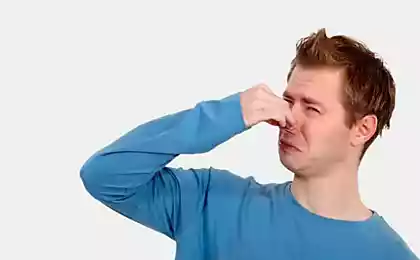577
Why, after workout clothes smell so gross
This mystery surrounds the basket of dirty Laundry, backpacks with sports locker rooms and gyms around the world. Why is one sports clothing stinks much more than the other after sports asks Gabriel Weston.
Going to the gym, each of us decides that it is better to wear: it may be an old stretched shirt a decade ago, a t-shirt from the collection of last season or special sports clothing with specific features developed using new technologies.
To be honest, we've all noticed that some things in our gym bag smell worse than others. And probably the most ever wondered why?
We have studied the latest research and conducted its own experiment to see if he knows the science solution to this problem is "tainted".

The study is based on a comparison of different fabrics and materials that become especially smelly after contact with the body.
Scientists from the University of Alberta in Canada and the Belgian University in Ghent attracted the most skilled sniffer dogs who were asked to test the smell of different things taken from people after sport.
Experts came to the conclusion that synthetics smell much stronger than natural, such as cotton or wool.
Curiously, it is not hard: our sweat itself has no odor.
The smell ariseswhen bacteria that live on our skin, begin to feed a certain type of sebaceous sweat, electric armpits and groin.
Why synthetics smell is stronger than other materials?

Inspired by existing methods of study of tissues, we conducted an experiment to determine whether clothes are made of cotton or polyester to have an impact on our skin bacteria, and as a consequence identify emerging smell.
In the experiment participated groups of volunteers from among intensively trained in two exercycle classes, which were used as training wear t-shirts of two types — made from 100% cotton or 100% polyester.
Before school in both classes the participants bravely refused to use deodorant — which must have greatly pleased their family, friends and work colleagues. In every class we took swabs from the armpits of the participants before and after training, and also collected their t-shirts for the analysis.
After analyzing these samples, Professor Andrew McBain and Dr Gavin Humphreys from the University of Manchester have discovered up to 300 different types of bacteria that live in the armpit of our volunteers.
The most common strains included Staphylococcus (Staphylococci), which are associated with normal odor of the human body, and Corynebacterium (Corynebacteria) that produce more odors.
Interestingly, though perhaps unsurprisingly, according to the study, staphylococci, tend to be more dominant in women's armpits, while the men have mostly dominated by more fetid corynebacteria.

But when it came to determine what impact different tissues in the axillary bacteria, our experts did not reveal significant differences.
They also found that, despite the large number of unpleasant smelling Corynebacterium on the skin, they have not passed on any of the shirts.
This argues in favor that the smell in the clothes is not created by bacteria on our skin, and in the synthetic fabric something is about to happen, which may explain the reason why they are stinking.
Dr. Rachel McQueen from University of Alberta in Canada after studying samples of knitted polyester, cotton and Merino wool suggested that one of the reasons so sharply distinguished smells that occur in these tissues, is a different texture and dynamic characteristics of natural and synthetic fibers.
This difference manifests itself, for example, the interplay between these types of fibers with moisture. Natural fibers of cotton absorb moisture, including bacteria produce odorous substances that get stuck within the fibers and thus do not reach the nose of the owner of the clothes.
Synthetic fibers do not absorb moisture, but absorb oily sebaceous secretions. Thus, these fibers cling "fatty substance" that is allocated to our then deposited on the fabric, and they in turn feed on bacteria that produce bad smell.

A group of scientists from the University of Ghent also made an amazing discovery, testing fiber sports clothes made of cotton and polyester that trained her owners.
Professor Nico boon, Dr Chris Callewaert and their colleagues found that a particularly foul-smelling bacteria, called Micrococcus in abundance multiplied on synthetic fibers, but did not show such activity on the cotton or on the skin.
10 exciting stories that can be read on the way to work
Neuroeconomics: how do we decide the risk and cooperate
So next time when you notice some sort of particularly strongly smelling the polyester clothing in my gym bag, can not engage in self-abuse: the perpetrators, in all probability, are themselves synthetic fiber fabric, so that malodorous bacteria a favorable environment in which they can successfully reproduce.published
Source: www.bbc.com/russian/features-37238484
Going to the gym, each of us decides that it is better to wear: it may be an old stretched shirt a decade ago, a t-shirt from the collection of last season or special sports clothing with specific features developed using new technologies.
To be honest, we've all noticed that some things in our gym bag smell worse than others. And probably the most ever wondered why?
We have studied the latest research and conducted its own experiment to see if he knows the science solution to this problem is "tainted".

The study is based on a comparison of different fabrics and materials that become especially smelly after contact with the body.
Scientists from the University of Alberta in Canada and the Belgian University in Ghent attracted the most skilled sniffer dogs who were asked to test the smell of different things taken from people after sport.
Experts came to the conclusion that synthetics smell much stronger than natural, such as cotton or wool.
Curiously, it is not hard: our sweat itself has no odor.
The smell ariseswhen bacteria that live on our skin, begin to feed a certain type of sebaceous sweat, electric armpits and groin.
Why synthetics smell is stronger than other materials?

Inspired by existing methods of study of tissues, we conducted an experiment to determine whether clothes are made of cotton or polyester to have an impact on our skin bacteria, and as a consequence identify emerging smell.
In the experiment participated groups of volunteers from among intensively trained in two exercycle classes, which were used as training wear t-shirts of two types — made from 100% cotton or 100% polyester.
Before school in both classes the participants bravely refused to use deodorant — which must have greatly pleased their family, friends and work colleagues. In every class we took swabs from the armpits of the participants before and after training, and also collected their t-shirts for the analysis.
After analyzing these samples, Professor Andrew McBain and Dr Gavin Humphreys from the University of Manchester have discovered up to 300 different types of bacteria that live in the armpit of our volunteers.
The most common strains included Staphylococcus (Staphylococci), which are associated with normal odor of the human body, and Corynebacterium (Corynebacteria) that produce more odors.
Interestingly, though perhaps unsurprisingly, according to the study, staphylococci, tend to be more dominant in women's armpits, while the men have mostly dominated by more fetid corynebacteria.

But when it came to determine what impact different tissues in the axillary bacteria, our experts did not reveal significant differences.
They also found that, despite the large number of unpleasant smelling Corynebacterium on the skin, they have not passed on any of the shirts.
This argues in favor that the smell in the clothes is not created by bacteria on our skin, and in the synthetic fabric something is about to happen, which may explain the reason why they are stinking.
Dr. Rachel McQueen from University of Alberta in Canada after studying samples of knitted polyester, cotton and Merino wool suggested that one of the reasons so sharply distinguished smells that occur in these tissues, is a different texture and dynamic characteristics of natural and synthetic fibers.
This difference manifests itself, for example, the interplay between these types of fibers with moisture. Natural fibers of cotton absorb moisture, including bacteria produce odorous substances that get stuck within the fibers and thus do not reach the nose of the owner of the clothes.
Synthetic fibers do not absorb moisture, but absorb oily sebaceous secretions. Thus, these fibers cling "fatty substance" that is allocated to our then deposited on the fabric, and they in turn feed on bacteria that produce bad smell.

A group of scientists from the University of Ghent also made an amazing discovery, testing fiber sports clothes made of cotton and polyester that trained her owners.
Professor Nico boon, Dr Chris Callewaert and their colleagues found that a particularly foul-smelling bacteria, called Micrococcus in abundance multiplied on synthetic fibers, but did not show such activity on the cotton or on the skin.
10 exciting stories that can be read on the way to work
Neuroeconomics: how do we decide the risk and cooperate
So next time when you notice some sort of particularly strongly smelling the polyester clothing in my gym bag, can not engage in self-abuse: the perpetrators, in all probability, are themselves synthetic fiber fabric, so that malodorous bacteria a favorable environment in which they can successfully reproduce.published
Source: www.bbc.com/russian/features-37238484
What visual illusions can tell us about our brain
Spiral mesh-trampoline at the Guggenheim Museum, new York























